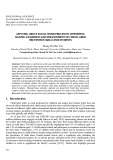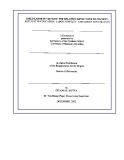
132
HNUE JOURNAL OF SCIENCE
Social Sciences 2024, Volume 69, Issue 4, pp. 132-142
This paper is available online at https://hnuejs.edu.vn
DOI: 10.18173/2354-1067.2024-0075
APPLYING GROUP SOCIAL WORK PROCESS IN SUPPORTING
RAISING AWARENESS AND ENHANCEMENT OF CHILD LABOR
PREVENTION SKILLS FOR STUDENTS
Hoang Thi Hai Yen
Faculty of Social Work, Hanoi National University of Education, Hanoi city, Vietnam
Corresponding author: Hoang Thi Hai Yen, e-mail: yenhth@hnue.edu.vn
Received October 16, 2024. Revised November 25, 2024. Accepted November 27, 2024.
Abstract. Child labor is a pervasive social issue that affects every continent and nearly every
country. Addressing this issue requires active involvement and close collaboration across all
levels, sectors, and components of society, including schools. Schools have organized child
labor prevention activities for students; however, the integration of social work methods,
particularly group social work approaches, remains limited. By applying group social work
methods, social workers can create a supportive group environment where students are
encouraged to enhance their skills, foster interaction, and complete both individual and
collective tasks through structured group activities. Drawing from the synthesis, analysis, and
evaluation of related studies, this article explores the application of group social work
processes to raise awareness and develop child labor prevention skills among secondary
school students. Through these methods, students can proactively build their prevention
capacity while still in school, empowering them to address this critical issue effectively.
Keywords: Child labor, group social work, prevention, awareness support, skill enhancement.
1. Introduction
Child labor refers to work performed by children and minors that violates labor laws and
adversely affects their physical, intellectual, emotional, and overall development [1]. It constitutes
a breach of children's rights under international human rights law as well as the legal frameworks
of many nations, including Vietnam [2]. Despite these protections, child labor remains a pressing
issue both globally and within Vietnam.
As of June 2021, the ILO and UNICEF's latest global estimates revealed that nearly 160
million children were engaged in child labor as of early 2020, representing almost one-tenth of
the world's total child population [3]. In Vietnam, there have been many different studies on the
status of child labor. The MICS report specifically highlighted that 6.3% of children aged 5-11
and 3.2% of children aged 12-14 both attend school and participate in economic activities beyond
the time limit. Furthermore, 2.3% of children both attend school and do hazardous work [4],
categorizing them as child laborers despite being enrolled in school. Several factors contribute to
the prevalence of child labor. Family-related factors play a significant role, including the
household’s financial situation [5-7], and the parents’ education levels [8-9]. Additionally, a lack
of awareness about working conditions and potential risks leads many rural families to send their
children to work to supplement the family’s income [10-11]. Studies also highlight personal
























